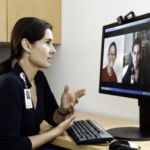Among the comments about my last article on this subject, a reader brought up my next topic — use of telemedicine for mental health support in schools.
I am a believer in telemedicine
- to the degree the professions are; and
- to the degree that such practices are circumscribed by law in Virginia.
I find, however, that creating the professionally specified environments for such telemedicine in the schools
- can be very difficult if not impossible;
- requires too much effort in schools stretched in their primary missions; and
- imposes liability they do not need.
Even then parents will have to get past the cultural stereotyping by the psychiatric community, which I will detail.
The community school model can provide tele-clinical environments and services in the vicinity of schools, but I recommend the schools stay out of it beyond testing for referrals.
Tele-Psychiatry. The American Psychiatric Association (APA) and the American Telemedicine Association (ATA) published in October 2022 Resource Document on Best Practices in Synchronous Videoconferencing-Based Telemental Health (Resource document).
I will caution readers to read the entire document rather than jumping straight to the section on “Child/Adolescent Populations.”
Read in “Program Development” about the needs assessment.
Then read “Legal and Regulatory” Issues:
- Licensure and Malpractice;
- Scope of Practice;
- Prescribing – a major difference between psychiatrists and psychologists. Psychiatrists are M.D.s and regularly prescribe controlled drugs in their practices;
- Informed Consent;
- Billing and Reimbursement;
- Patient Education.
Then read “Standard Operating Procedures/Protocols.”
Prior to initiating TMH services, any organization or provider shall have in place a set of standard operating procedures or protocols that should include (but are not limited to) the following administrative, clinical, and technical specifications.
• Roles, responsibilities (i.e., daytime and after-hours coverage), communication, and procedures around emergency issues.
• Agreements to ensure licensing, credentialing, training, and authentication of providers as well as identity authentication of patients according to local, state, and federal requirements.
• A systematic quality improvement and performance management process that complies with any organizational, regulatory, or accrediting requirements for outcomes management.
• Procedures for identifying patients who may best be served by TMH, in-person, or hybrid care.
• Procedures and guidance for transitioning patients between TMH and in- person care.
• Procedures for technology selection.
Read about “clinically supervised settings.”
Then about “clinically unsupervised settings” — instances where the mental health provider is providing services to patients in settings without clinical staff immediately available. That is the situation many schools would face.
Both settings have daunting requirements.
Then the “Technical Considerations.”
Organizations shall ensure the technical readiness of the telehealth equipment and its arrangement within the clinical environment. They shall have policies and procedures in place to ensure the physical security of telehealth equipment and the electronic security of data. Organizations shall ensure compliance with all relevant safety laws, regulations, and codes for technology and technical safety.
Then the “Physical Location/Room Requirements.”
Then “Clinical Considerations“ including patient and setting selection, ethical considerations, cultural issues.
Finally under “Specific Populations and Settings” you will get to “Child/Adolescent Populations.” Read that.
Blatant stereotyping of patients. Then read the considerations for other listed populations and settings.
There you will read that their professional judgments include some of the most simplistic, race-centric (if not racist) preconceptions and stereotyping you will ever have seen in print.
You will see, for example, they expect no guns or “kinship” anywhere but in rural communities. You know, White Scotch-Irish people. Perhaps guns and kinship are as far as they dared go.
Black kids, indigenous kids, Asian kids and Latinx (ouch) kids are affected by “intergenerational trauma, interpersonal racism, vicarious racism and intergenerational racism.” No guns there.
No drug and alcohol problems specified in any of the listed communities.
Perhaps because psychiatrists are dealers in drugs to children.
Psychiatrists and drugs for kids. Informed by those stereotypes, psychiatrists can and do prescribe antidepressants, antipsychotics, anti-ADHD medicines and mood stabilizers.
Scary thought.
A Harvard study warns of the side effects and cautions parents to ask questions.
- What is this medication for?
- What are the potential side effects?
- How long should my child stay on this medication?
- What else should I understand?
The study warns:
Especially for children and teens, it is essential to approach behaviors holistically by considering biology, psychology, and social and environmental factors.
Social and environmental factors like the stereotypes in the Resource Document?
Will all parents know to ask those questions? No.
Another reason for the schools to stay out of it.
Tele-Psychology. The American Psychological Association has published, minus the insulting and perhaps disqualifying stereotypes of the psychiatrists, Guidelines for the Practice of Telepsychology.
It sets technical standards, operating procedures, physical location requirements and other guidelines similar to those of the psychiatrists.
But there are no drug prescriptions.
Bottom line. Schools will have a very hard time meeting all of the mental telehealth requirements.
They would be badly advised to try. Two words for schools: practicality and liability.
I have recommended in the past that we pursue in medically underserved communities community schools served by adjacent or nearby medical facilities.
If the community schools model is executed, telemedicine for clinical mental health support is possible.
I just don’t advise the schools participate beyond testing for referrals.


Leave a Reply
You must be logged in to post a comment.